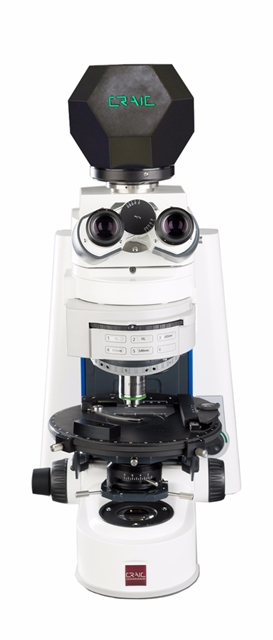Controlling light’s polarization at the moment it is emitted is a powerful capability. It unlocks new possibilities in optical displays, quantum information science, and biosensing. At the heart of this capability is chirally selective luminescence, where light strongly prefers one circular polarization over the other. Traditional methods rely on chiral molecules, but their inherent asymmetry is often too weak to be practical. Instead, researchers are turning to a more robust solution. By combining achiral emitters with twisted metasurfaces, they can generate robust, tunable circularly polarized light in ultra-thin devices. That degree of control is only possible through meticulous spatial engineering, guided by thin film thickness measurements and validated through UV-Vis-NIR microspectroscopy. Together, these tools are redefining how circular polarization is designed, quantified, and applied.
Circularly polarized luminescence (CPL) is vital for emerging technologies in optics and display design, but generating it with both efficiency and full-spectrum color remains a challenge. Quantum dots provide tunable brightness across the visible range but emit unpolarized light. Chiral cellulose nanocrystals (CNCs), by contrast, offer a structured, bio-derived platform for controlling light polarization. When combined, they form a system capable of transforming color-rich emission into precisely polarized output.
CRAIC Technologies Introduces Revolutionary Maceral Identification Solution for Coal Analysis
[San Dimas, CA, June 30, 2025] — CRAIC Technologies, a leading innovator in the field of scientific instrumentation, is proud to announce the launch of its groundbreaking maceral identification solution, designed to revolutionize coal analysis for researchers and industries worldwide.
Coal, a cornerstone of global energy production, undergoes intricate analysis processes to determine its composition and suitability for various applications. Macerals, the organic constituents of coal, play a crucial role in understanding its quality, properties, and behavior during combustion. Accurate maceral identification is essential for optimizing coal usage, improving efficiency, and mitigating environmental impact. Traditionally, maceral identification has been a time-consuming and labor-intensive process, requiring extensive sample preparation and manual microscopic analysis. However, CRAIC Technologies' innovative solution leverages high speed imaging techniques to streamline and speed completion of this critical task.
"Our new maceral identification solution represents a significant advancement in coal analysis technology," said Dr. Paul Martin, CEO of CRAIC Technologies. "By combining advanced imaging capabilities, servo driven scanning and sophisticated software, we are empowering petrographers and industry professionals to achieve unprecedented levels of accuracy, efficiency, and insight in maceral identification."
 CRAIC Technologies' maceral identification solution promises to enhance throughput of coal analysis across a range of applications, including mining, energy generation, environmental research, and academic study. By empowering researchers and industry professionals with advanced tools and capabilities, the company aims to drive innovation, efficiency, and sustainability in the global coal industry.
CRAIC Technologies' maceral identification solution promises to enhance throughput of coal analysis across a range of applications, including mining, energy generation, environmental research, and academic study. By empowering researchers and industry professionals with advanced tools and capabilities, the company aims to drive innovation, efficiency, and sustainability in the global coal industry.
For more information about CRAIC Technologies' maceral identification solution and other innovative scientific instrumentation offerings, please visit
microspectra.com or contact us at sales@microspectra.com.
About CRAIC Technologies:
CRAIC Technologies is a leading provider of innovative spectroscopic solutions, specializing in the design and manufacture of advanced instruments for spectral analysis and imaging. With a commitment to excellence and customer satisfaction, CRAIC Technologies continues to push the boundaries of spectroscopic technology, empowering researchers and industry professionals with state-of-the-art tools for scientific discovery and analysis.
Contact information:
CRAIC Technologies, Inc.
https://www.microspectra.com/
sales@microspectra.com
+1-310-573-8180
In photovoltaics, 2D materials, and semiconductors, performance often hinges on what happens at the microscopic scale. As devices shrink and materials become more architecturally complex, microspectrophotometers provide the localized, high-resolution spectral data needed to reveal hidden inconsistencies, validate layer quality, and inform smarter fabrication. They bring clarity to the fine structure of modern materials, revealing how variations at the micron scale can impact overall performance.
Cholesteric-superhelix films have captivated scientists and engineers with their ability to manipulate light in precise and tunable ways. Their complex internal architectures, defined by a hierarchy of helical structures, offer exciting potential for applications ranging from optical sensing to secure data storage. Yet, truly understanding such intricate materials requires a method that can reveal their hidden chiral features without altering or damaging them. Circularly polarized luminescence (CPL) from upconversion nanorods provides a practical method for examining the films’ internal helical formations in detail, offering new insight into how these materials function and respond.

